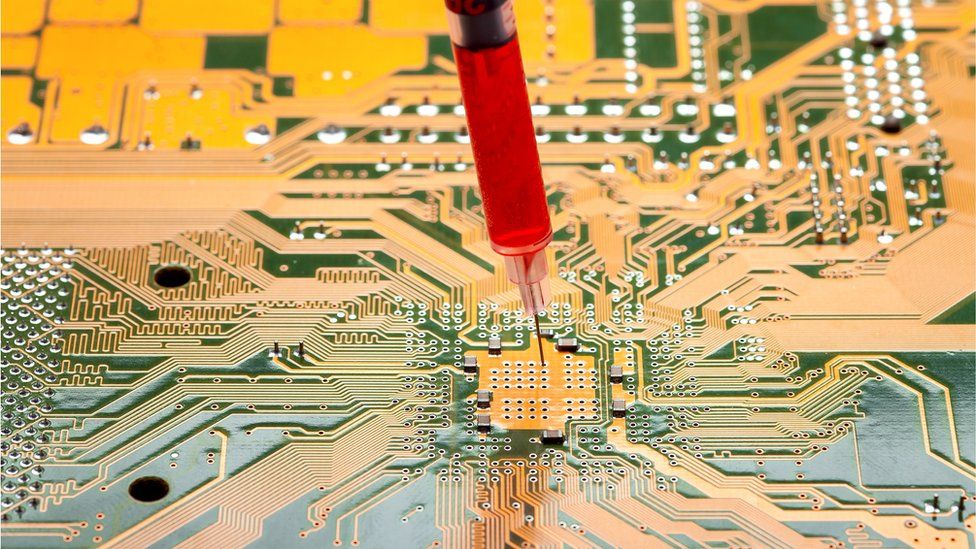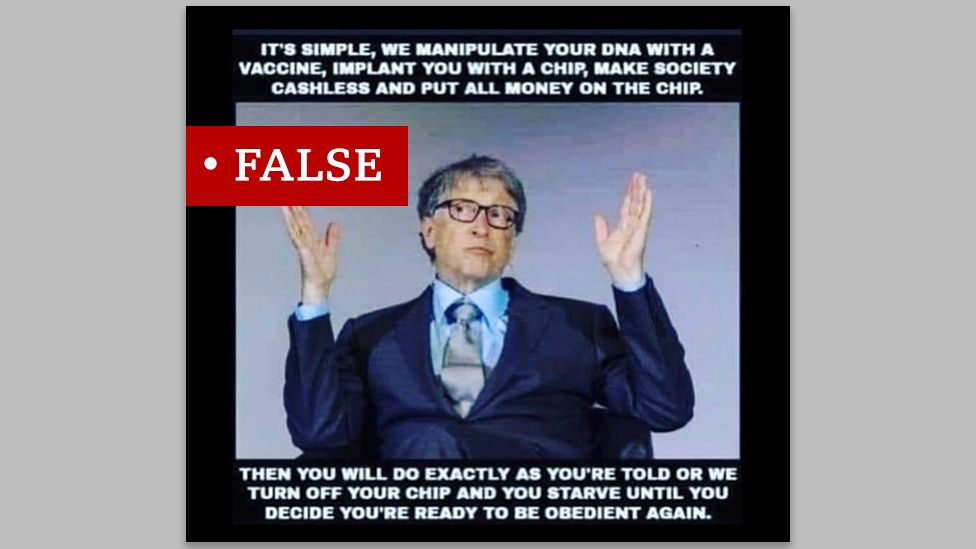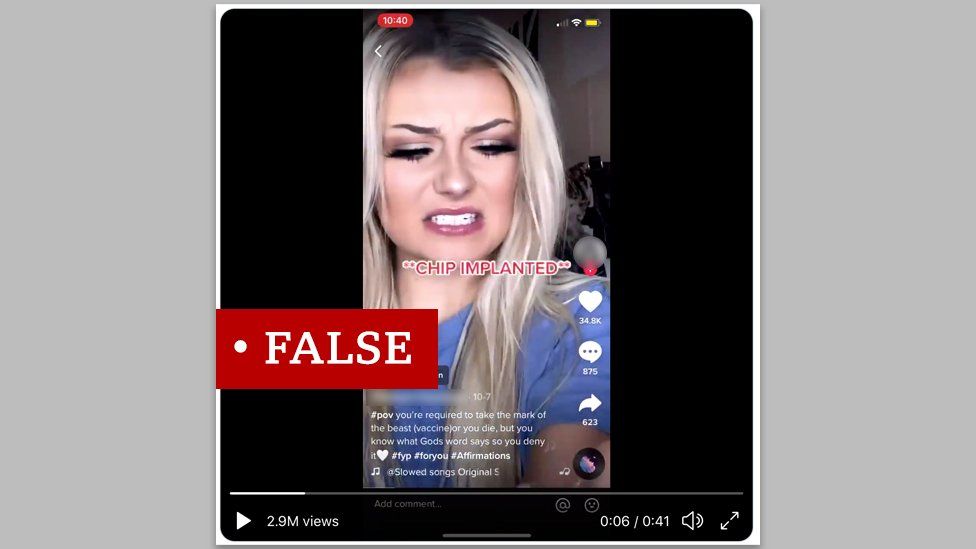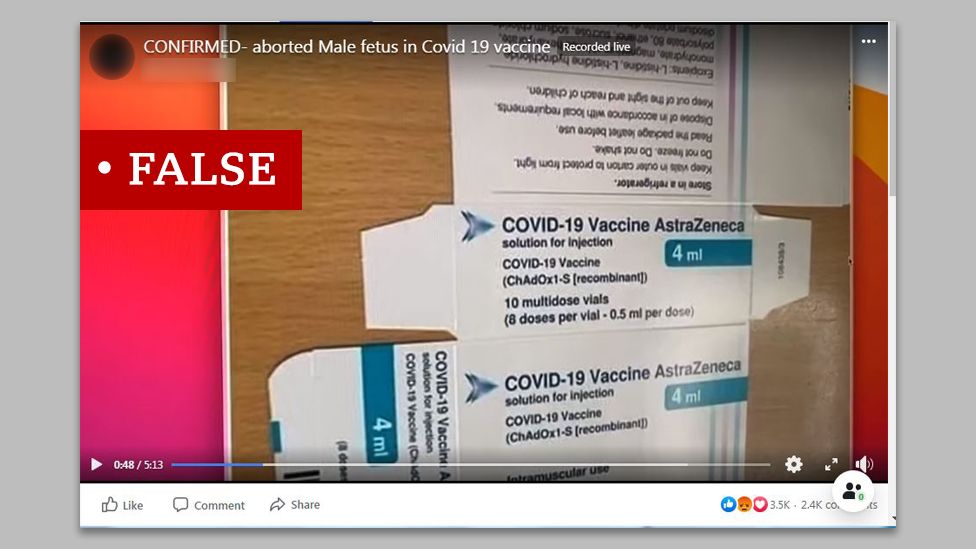Vaccine rumours debunked: Microchips, 'altered DNA' and more
 image copyrightGetty Images
image copyrightGetty ImagesWe've looked into some of the most widely shared false vaccine claims - everything from alleged plots to put microchips into people to the supposed re-engineering of our genetic code.
'Altered DNA' claims
The fear that a vaccine will somehow change your DNA is one we've seen aired regularly on social media.
The BBC asked three independent scientists about this. They said that the coronavirus vaccine would not alter human DNA.
Some of the newly created vaccines, including the one now approved in the UK developed by Pfizer/BioNTech, use a fragment of the virus's genetic material - or messenger RNA.
"Injecting RNA into a person doesn't do anything to the DNA of a human cell," says Prof Jeffrey Almond of Oxford University.
It works by giving the body instructions to produce a protein which is present on the surface of the coronavirus.
The immune system then learns to recognise and produce antibodies against the protein.

This isn't the first time we've looked into claims that a coronavirus vaccine will supposedly alter DNA. We investigated a popular video spreading the theory back in May.
Posts have noted that messenger RNA (mRNA) vaccine technology "has never been tested or approved before".
It is true that no mRNA vaccine has been approved before now, but multiple studies of mRNA vaccines in humans have taken place over the last few years. And, since the pandemic started, the vaccine has been tested on tens of thousands of people around the world and has gone through a rigorous safety approval process.
Like all new vaccines, it has to undergo rigorous safety checks before it can be recommended for widespread use.
In Phase 1 and Phase 2 clinical trials, vaccines are tested in small numbers of volunteers to check they are safe and to determine the right dose.
In Phase 3 trials they are tested in thousands of people to see how effective they are. The group who received the vaccine and a control group who have received a placebo are closely monitored for any adverse reactions - side-effects. Safety monitoring continues after a vaccine has been approved for use.
Bill Gates and microchip claims
Next, a conspiracy theory that has spanned the globe.
It claims that the coronavirus pandemic is a cover for a plan to implant trackable microchips and that the Microsoft co-founder Bill Gates is behind it.
There is no vaccine "microchip" and there is no evidence to support claims that Bill Gates is planning for this in the future.
The Bill and Melinda Gates Foundation told the BBC the claim was "false".

Rumours took hold in March when Mr Gates said in an interview that eventually "we will have some digital certificates" which would be used to show who'd recovered, been tested and ultimately who received a vaccine. He made no mention of microchips.
This led to one widely shared article headlined: "Bill Gates will use microchip implants to fight coronavirus."
The article makes reference to a study, funded by The Gates Foundation, into a technology that could store someone's vaccine records in a special ink administered at the same time as an injection.
However, the technology is not a microchip and is more like an invisible tattoo. It has not been rolled out yet, would not allow people to be tracked and personal information would not be entered into a database, says Ana Jaklenec, a scientist involved in the study.
The billionaire founder of Microsoft has been the subject of many false rumours during the pandemic.
He's been targeted because of his philanthropic work in public health and vaccine development.
Despite the lack of evidence, in May a YouGov poll of 1,640 people suggested 28% of Americans believed Mr Gates wanted to use vaccines to implant microchips in people - with the figure rising to 44% among Republicans.
Fetus tissue claims
We've seen claims that vaccines contain the lung tissue of an aborted fetus. This is false.
"There are no fetal cells used in any vaccine production process," says Dr Michael Head, of the University of Southampton.

One particular video that was posted on one of the biggest anti-vaccine Facebook pages refers to a study which the narrator claims is evidence of what goes into the vaccine developed by AstraZeneca and Oxford University. But the narrator's interpretation is wrong - the study in question explored how the vaccine reacted when introduced to human cells in a lab.
Confusion may have arisen because there is a step in the process of developing a vaccine that uses cells grown in a lab, which are the descendants of embryonic cells that would otherwise have been destroyed. The technique was developed in the 1960s, and no fetuses were aborted for the purposes of this research.
Many vaccines are made in this way, explains Dr David Matthews, from Bristol University, adding that any traces of the cells are comprehensively removed from the vaccine "to exceptionally high standards".
The developers of the vaccine at Oxford University say they worked with cloned cells, but these cells "are not themselves the cells of aborted babies".
The cells work like a factory to manufacture a greatly weakened form of the virus that has been adapted to function as a vaccine.
But even though the weakened virus is created using these cloned cells, this cellular material is removed when the virus is purified and not used in the vaccine.
Recovery rate claims
We've seen arguments against a Covid-19 vaccine shared across social media asking why we need one at all if the chances of dying from the virus are so slim.
A meme shared by people who oppose vaccination put the recovery rate from the disease at 99.97% and suggested getting Covid-19 is a safer option than taking a vaccine.

To begin with, the figure referred to in the meme as the "recovery rate" - implying these are people who caught the virus and survived - is not correct.
About 99.0% of people who catch Covid survive it, says Jason Oke, senior statistician at the University of Oxford.
So around 100 in 10,000 will die - far higher than three in 10,000, as suggested in the meme.
However, Mr Oke adds that "in all cases the risks very much depend on age and do not take into account short and long-term morbidity from Covid-19".
It's not just about survival. For every person who dies, there are others who live through it but undergo intensive medical care, and those who suffer long-lasting health effects.
This can contribute to a health service overburdened with Covid patients, competing with a hospital's limited resources to treat patients with other illnesses and injuries.
Concentrating on the overall death rate, or breaking down the taking of a vaccine to an individual act, misses the point of vaccinations, says Prof Liam Smeeth of the London School of Hygiene and Tropical Medicine. It should be seen as an effort by society to protect others, he says.
"In the UK, the worst part of the pandemic, the reason for lockdown, is because the health service would be overwhelmed. Vulnerable groups like the old and sick in care homes have a much higher chance of getting severely ill if they catch the virus".
Additional reporting by Kris Bramwell, Olga Robinson and Marianna Spring





No comments